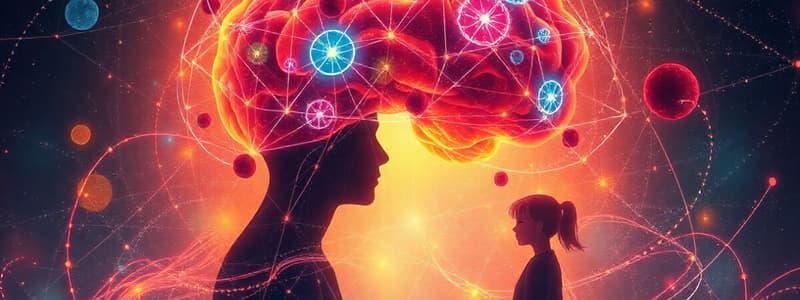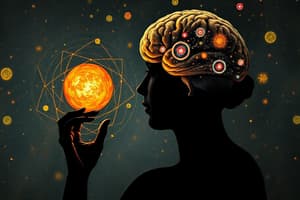Podcast
Questions and Answers
What is the primary role of the Anterior Cingulate Cortex in social cognition?
What is the primary role of the Anterior Cingulate Cortex in social cognition?
- Motivation and decision making (correct)
- Socio-emotional processing
- Self-referential processing
- Planning and prediction
Which structure is indicated as primarily responsible for self-referential processing?
Which structure is indicated as primarily responsible for self-referential processing?
- Ventral Medial Prefrontal Cortex (correct)
- Posterior Cingulate Cortex
- Angular Gyrus
- Medial Parietal Cortex
How does grooming in non-human primates influence their relationships?
How does grooming in non-human primates influence their relationships?
- It decreases bonding and rank awareness.
- It has no significant impact on relationships.
- It solely protects them from external threats.
- It improves bonding and reduces aggression. (correct)
What is a significant effect of abuse and isolation on brain function?
What is a significant effect of abuse and isolation on brain function?
What cognitive function is associated with the Medial Prefrontal Cortex during self-referential tasks?
What cognitive function is associated with the Medial Prefrontal Cortex during self-referential tasks?
Which structure is implicated in the processing of the sense of self?
Which structure is implicated in the processing of the sense of self?
What does the Ventromedial Prefrontal Cortex (vmPFC) enable us to predict?
What does the Ventromedial Prefrontal Cortex (vmPFC) enable us to predict?
What cognitive impact does stimulating the Angular Gyrus have?
What cognitive impact does stimulating the Angular Gyrus have?
What is the Self-Reference Effect in terms of cognition?
What is the Self-Reference Effect in terms of cognition?
What primary role does the Temporoparietal Junction (TPJ) play in relation to self-perception?
What primary role does the Temporoparietal Junction (TPJ) play in relation to self-perception?
Damage to which structure is associated with inappropriate social behavior?
Damage to which structure is associated with inappropriate social behavior?
Which part of the brain is associated with the awareness of the self compared to others?
Which part of the brain is associated with the awareness of the self compared to others?
When processing self-related information, which brain area becomes active?
When processing self-related information, which brain area becomes active?
What is the function of the Unpleasantness Circuit involving the Anterior Cingulate Cortex and Anterior Insula?
What is the function of the Unpleasantness Circuit involving the Anterior Cingulate Cortex and Anterior Insula?
Which system is primarily engaged in facilitating rapid olfactory learning in infants?
Which system is primarily engaged in facilitating rapid olfactory learning in infants?
What triggers the activation of the Ventral Striatum in the context of social competition?
What triggers the activation of the Ventral Striatum in the context of social competition?
What type of hallucinations are described as seeing double without a feeling of detachment from the body?
What type of hallucinations are described as seeing double without a feeling of detachment from the body?
What is the relationship between mirror neuron network and emotional processing?
What is the relationship between mirror neuron network and emotional processing?
Which brain structure is primarily involved in assessing the negative behaviors of others in social norms?
Which brain structure is primarily involved in assessing the negative behaviors of others in social norms?
What does social support primarily achieve in relation to amygdala activity?
What does social support primarily achieve in relation to amygdala activity?
Flashcards
Mentalizing
Mentalizing
Inferring the mental states of others.
Introspection
Introspection
Knowledge about oneself.
Eusociality
Eusociality
Co-habitation across generations.
Social Cognition Networks
Social Cognition Networks
Signup and view all the flashcards
Anterior Cingulate Cortex (ACC)
Anterior Cingulate Cortex (ACC)
Signup and view all the flashcards
Ventromedial Prefrontal Cortex (vmPFC)
Ventromedial Prefrontal Cortex (vmPFC)
Signup and view all the flashcards
Posterior Cingulate Cortex
Posterior Cingulate Cortex
Signup and view all the flashcards
Medial Parietal Cortex
Medial Parietal Cortex
Signup and view all the flashcards
Orbitofrontal Cortex (OFC) damage
Orbitofrontal Cortex (OFC) damage
Signup and view all the flashcards
Abuse/Isolation Effects
Abuse/Isolation Effects
Signup and view all the flashcards
Self-Reference Effect
Self-Reference Effect
Signup and view all the flashcards
Medial Prefrontal Cortex
Medial Prefrontal Cortex
Signup and view all the flashcards
Sense of Self
Sense of Self
Signup and view all the flashcards
Default Mode Network (DMN)
Default Mode Network (DMN)
Signup and view all the flashcards
Positive Self-Appraisal
Positive Self-Appraisal
Signup and view all the flashcards
Ventral Anterior Cingulate Cortex
Ventral Anterior Cingulate Cortex
Signup and view all the flashcards
OFC
OFC
Signup and view all the flashcards
Ventromedial Prefrontal Cortex (vmPFC)
Ventromedial Prefrontal Cortex (vmPFC)
Signup and view all the flashcards
Angular Gyrus and TPJ
Angular Gyrus and TPJ
Signup and view all the flashcards
Out-of-body experience
Out-of-body experience
Signup and view all the flashcards
Autoscopic hallucination
Autoscopic hallucination
Signup and view all the flashcards
TPJ
TPJ
Signup and view all the flashcards
Mirror Neuron Network
Mirror Neuron Network
Signup and view all the flashcards
MPFC
MPFC
Signup and view all the flashcards
Dorsal MPFC
Dorsal MPFC
Signup and view all the flashcards
Ventral MPFC
Ventral MPFC
Signup and view all the flashcards
Unpleasantness Circuit
Unpleasantness Circuit
Signup and view all the flashcards
Anterior Cingulate Cortex (ACC)
Anterior Cingulate Cortex (ACC)
Signup and view all the flashcards
Amygdala
Amygdala
Signup and view all the flashcards
Social Support
Social Support
Signup and view all the flashcards
DMN (Default Mode Network)
DMN (Default Mode Network)
Signup and view all the flashcards
ASD (Autism Spectrum Disorder)
ASD (Autism Spectrum Disorder)
Signup and view all the flashcards
Study Notes
Mentalizing and Introspection
- Mentalizing involves inferring the mental states of others.
- Introspection refers to knowledge about oneself.
Social Cognition Networks
- Anterior Cingulate Cortex (ACC): Associated with motivation, decision-making, conflict monitoring, and cost-benefit analysis.
- Ventromedial Prefrontal Cortex (vmPFC): Involved in self-referential processing and subjective feelings.
- Posterior Cingulate Cortex: Important for planning and predictions.
- Medial Parietal Cortex: Plays a role in socio-emotional processing and perception.
- Orbital Frontal Cortex (OFC): Damage leads to inappropriate social behaviors.
Impact of Abuse and Isolation
- Abuse and isolation can impair synaptic plasticity.
- They increase fear, aggression, and anxiety.
- They alter prefrontal cortex function.
- They decrease dopamine and increase serotonin signaling.
- Perception of isolation correlates with Alzheimer's disease risk, lower IQ, and depression.
- They are associated with decreased glucocorticoid receptor sensitivity and increased Default Mode Network (DMN) sensitivity.
Self-Reference Effect
- Information processed in relation to the self is better encoded and recalled (self-reference effect).
- Medial Prefrontal Cortex activity increases during this process.
- Posterior Parietal Cortex is involved in the sense of self.
Default Mode Network (DMN) in Sense of Self
- DMN is active even at rest and particularly involved in the sense of self.
- DMN components include Ventral Medial Prefrontal Cortex, Dorsal Medial Prefrontal Cortex, Inferior Parietal Lobule, Retrosplenial Cingulate Cortex, and Temporal Parietal Junction.
- VDIRT is part of DMN, facilitating self-reflection, future actions, current condition evaluation, and considering other beliefs/actions.
Positive Self-Appraisal
- Anterior Cingulate Cortex is crucial for positive self-appraisals.
- Ventral Anterior Cingulate Cortex focuses attention during self-appraisal.
- OFC contributes to accurate self-perception.
Ventromedial Prefrontal Cortex (vmPFC) and Future Mental States
- vmPFC allows prediction of future mental states of oneself and others, and simulates social scenarios.
- vmPFC activity increases when delaying rewards.
- Damage to the vmPFC impairs the ability to predict likes/dislikes.
Angular Gyrus and Temporal Parietal Junction (TPJ)
- Angular Gyrus and TPJ mediate the unity between self and body.
- Stimulating the angular gyrus disrupts this unity.
- TPJ facilitates thinking from another person's perspective and out-of-body experiences.
Autoscopic Hallucinations
- These involve seeing double oneself but not feeling out of body.
- They can result from failures in combining visual, vestibular, proprioceptive, or tactile information.
Infant Brain Development
- Infant occipital cortex shows gamma-range activation during facial expression processing.
- Prefrontal cortex activation occurs in response to eye contact.
- Amygdala response is dampened to prevent negative associations with the mother.
- Noradrenergic system supports rapid olfactory learning development.
Ventral vs. Dorsal Medial Prefrontal Cortex (MPFC)
- Ventral MPFC is active when perceiving self or romantic partner.
- Dorsal MPFC is active when perceiving someone dissimilar to oneself.
Mirror Neuron Network and Amygdala
- Mirror Neuron Network (which includes MPFC, ventrolateral PFC, and Anterior Cingulate Gyrus) connects to amygdala via insula.
Unpleasantness Circuit
- Anterior Cingulate Cortex and Anterior Insula are part of the unpleasantness circuit.
Thinking About Self vs. Others
- Dorsal ACC is active when processing self, but not others.
- Right MPFC is more active when thinking about the self, and left MPFC for others.
- Dorsal Medial Prefrontal Cortex is activated when thinking about the behaviors of others.
Fairness and Pain
- Insula and Anterior Cingulate Cortex are active in people who are fair and experience pain.
- Nucleus accumbens and Ventral Striatum are activated in males who are cheaters and experience pain.
Emotional Responses to Team Outcomes
- Anterior Cingulate Cortex is active when a favorite team loses.
- Ventral Striatum is active when a rival team loses (schadenfreude).
Frontotemporal Dementia (FTDL)
- FTDL patients often have a lessened vmPFC function, leading to them ranking negative behaviors as more acceptable.
Intentional vs. Accidental Harm
- Amygdala makes associations between intentional and accidental harm.
- TPJ stimulation, implying "no harm, no foul," suppresses amygdala responses to unintentional transgressions.
Cognitive Domains (rule-based vs. personal)
- DLPFC and PFC are associated with rule-based reasoning.
- TPJ and Parietal Cortex are associated with personal interpretation and evaluation.
Social Support
- Social support inhibits amygdala activity, pain/threat detection, opioid release, HPA and SNS activation, and increases vmPFC activity. It also suppresses insula and ACC activity.
Autism Spectrum Disorder (ASD)
- DMN is consistently offline in ASD.
- Neurons in the hippocampus show immature spines in ASD.
Neurological Damage and Language impairment
- Damage to Broca's area, supplementary motor area, basal ganglia, Thalamus, ACC, OFC, and posterior parietal cortex can affect social functioning and language.
Studying That Suits You
Use AI to generate personalized quizzes and flashcards to suit your learning preferences.


